
Guide to Printing Students — 34
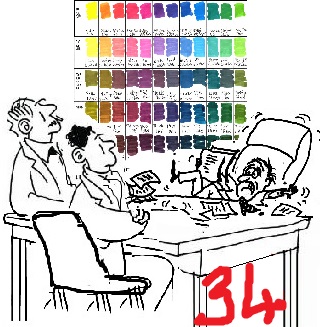
-Few objective Questions and answers-
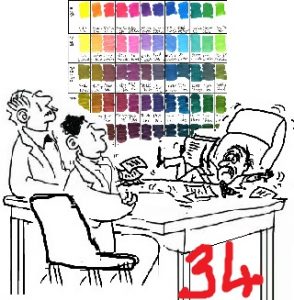
Written by : N.R. Jayaraman
143) What is known as standing matter?
In the Letterpress printing presses a vast amount of composed and imposed type matters in pages is kept either wrapped in the galleys or locked up in frames expecting the repeat order to be received within reasonable time. Such an occasion arises when the customer requests the presses to keep the forms standing and the standing rental charges are paid by them for certain fixed periods or the presses themselves based on their previous experience keep certain forms standing hoping to get repeat orders. The locked up composed type metal fonts thus kept unusable for other jobs till such time the composed matter is distributed back to the cases for composing text for fresh job is called standing matter. This term applies to the Letterpress process of printing only.
In the cases of Offset and other processes of printing the standing matters will be only in the form of film negatives, positives or used polymer or rubber or nylon based plates or blocks which in any case cannot be reused for other jobs and has to be destroyed after use even if it applies to reprint order. The unusable plates and negatives-positives are not destroyed then and there after completion of each job and collected in bulk and destroyed later. Therefore they are not technically called standing matters.
144) Which factors determine the consumption of ink ?
The ink consumption depends on the following factors:
- Whether the printing is by Offset or Letter press process
- Area of ink coverage on paper
- Whether solid matter or very light and skeleton formats.
- The type of paper on which the printing is done
- Quantity to be printed- whether long run or short run copies.
- Color ink or black and dark colored ink
- 3 or 4 colour Process inks or heavily pigmented special colored inks
- Metallic inks or normal ink
For solid matter, the ink consumption will be very high, while for text matter and skeleton forms, the ink coverage is very less even though the printing area may be same. Let us say that the printing is done on A4 size paper with one inch margin on all four sides. The ink coverage for solid forms may be 100 % while normal spaced composed text matter with halftone illustration may require only 30 to 35 % of ink than the one used for solids. Prints containing less than no of words per page with few lines may not need the same amount of ink compared to heavily worded forms printing. See below three forms. When No 1 is estimated to consume 300 Grms ink per 1000 copies, No 2 may need 400 Grms while No 3 may need 500 Grms of ink.
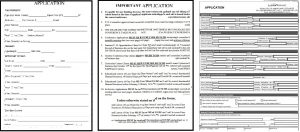
Therefore the general pattern of ink consumption accepted for both the Letterpress and Offset job is calculated for different text forms as under.
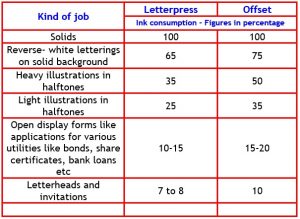
Based on the per 1000 copies per 10000 sq mm area data provided by the suppliers of ink and own experience, taking into consideration the machine conditions and expertise in handling, the estimator works the consumption pattern of inks for various jobs with above as one of the factors.
145) How does the paper influence the ink consumption being estimated?
Each paper has their own properties in respect of absorbing the ink and drying. For example a rough sized paper absorb more ink while the art paper consumes less ink because the ink on them dry by evaporation cum oxidation process absorbing very little into its base to retain the hold of the ink. The soft and rough paper quickly absorb the inks into their surface and therefore more ink is needed to show the density of ink over its surface. So the general principle is that the soft, rough uncoated papers absorb more ink and the super calendared, art and coated papers absorb less ink which tell upon the consumption. The estimator has to carefully decide and work out the ink consumption on those papers.
Since the consumption pattern of the inks differs from press to press the estimator keep sample work outs of ink consumption based on the past experience of consumption on various papers with various inks. Fixed consumption pattern of consumable item like cannot be made available except the guide line consumption given by the ink manufacturers based on which one has to draw their own conclusion by in-house work pattern.
The general pattern of ink consumption accepted for various kinds of paper is calculated as under.
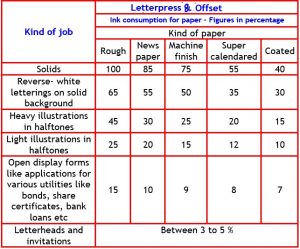
146) How is the ink consumption estimated and standardized?
For any kind of job in printing, the ink consumption is separately estimated to recover the cost. While recovering the cost, a small extra percentage is added to cover the expenses on purchase, storing, issuing, additional driers used, wash ups of ink rollers besides drying of ink in the cans and tins and in the ink duct. Therefore the estimator has to regularly check the balance stocks of various inks to compare with the no of jobs executed. The comparison would be stock in balance before the job commenced and stock in balance after end of the job to match the estimated consumption and actual consumption.
Always remember that the estimation for the ink for Offset and Letterpress processes are different. Though the manufacturers generally supply standard tables and formulae for the consumption pattern of inks for various jobs which can be used as guiding factor, one has to carefully consider many factors to determine the actual consumption of the inks for various jobs as suggested under question 144.
However the generally accepted pattern of the consumption of ink based on experience of several presses is stated to be as below:
- Consumption of black colour ink per 1000 copies of A4 size on coated paper is = 140 to 150 gms approx.
- Consumption of black colour ink per 1000 copies of A4 size of uncoated paper = 210-225 gms approx.
However the consumption of each of the colours in the 3 to 4 process colours like Yellow, Cyan, Magenta and black will be only 50 to 60 % of the above since they fall one upon the other in print.
The standard of 150 grams per 1000 copies for A4 size paper is only a guiding factor, but it certainly cannot be something like 300 grams or 400 grams which will show that your technical processing needs correction and is faulty and therefore one has to standardize their own average consumption pattern based on various jobs executed and the consumption of inks therefor.
The average consumption of ink is estimated as thus:
- Per page square inch area to be printed x total no of copies to be printed = A (area in square inches)
- % of ink coverage based on type of paper and design = B (percentage)
- Ink consumption per 100000 square inches based on previous experience = C (Kgs or grams)
- Final ink required = A x B divided by C x 100,000 Kgs or Grams








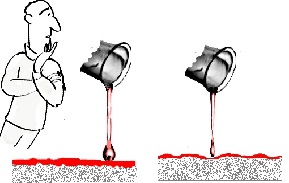







Recent Comments